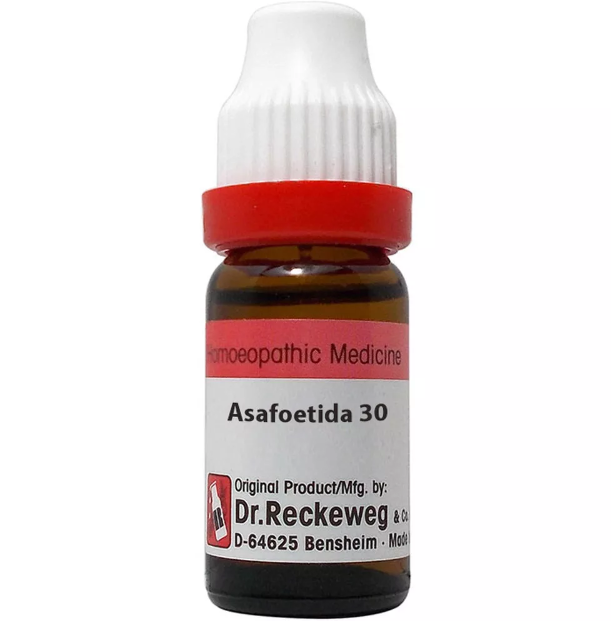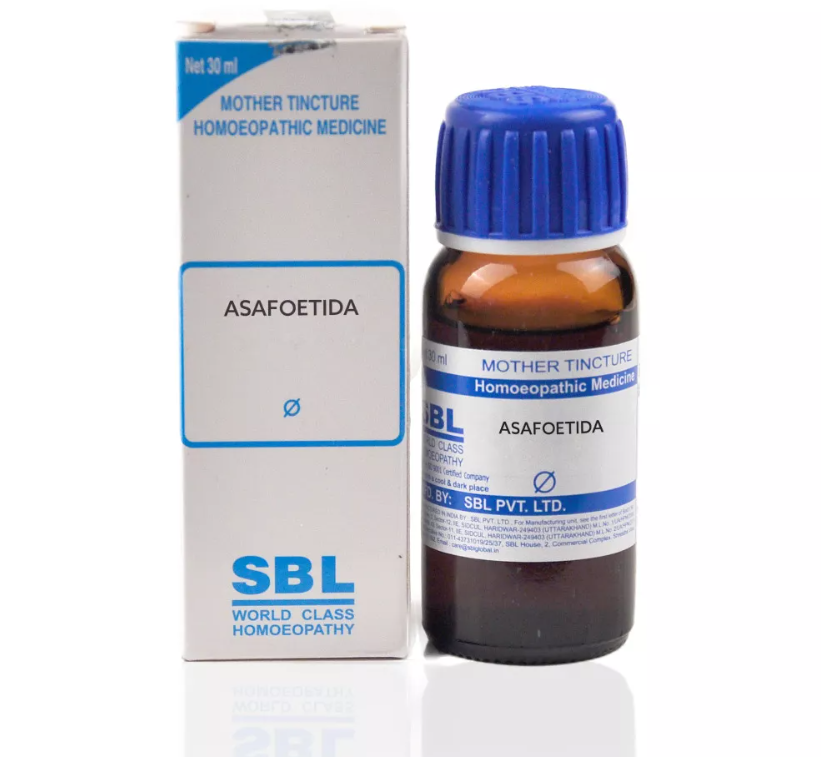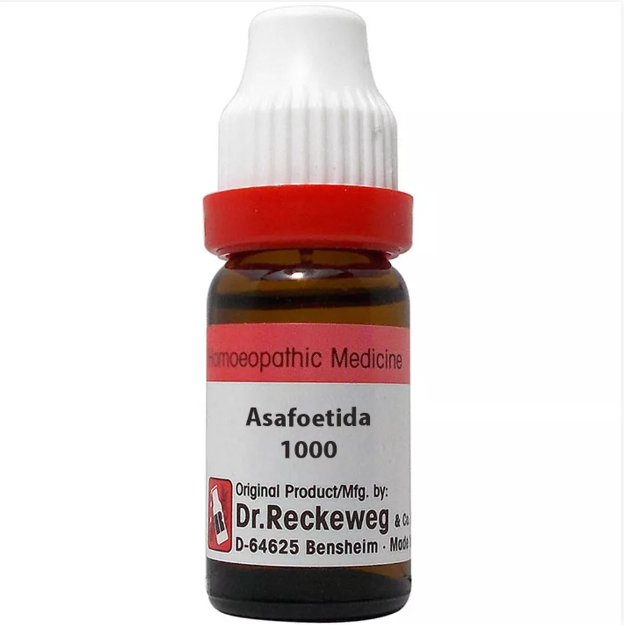ASA FOETIDA Q, 6C, 12C, 30C, 200C, 1M, 10M USES AND SYMPTOMS
 Asafoetida (Gum of the Stinkasand) is a remedy known for its effectiveness in addressing flatulence, spasmodic contractions of the stomach and esophagus, and reverse peristalsis. It is particularly suited for individuals with hysterical or hypochondriacal tendencies. Additionally, it is beneficial for deep ulcerations, bone caries, especially in those with a syphilitic constitution, where extreme sensitivity, intense throbbing, and nocturnal pains are prominent indicators for its use.
Asafoetida (Gum of the Stinkasand) is a remedy known for its effectiveness in addressing flatulence, spasmodic contractions of the stomach and esophagus, and reverse peristalsis. It is particularly suited for individuals with hysterical or hypochondriacal tendencies. Additionally, it is beneficial for deep ulcerations, bone caries, especially in those with a syphilitic constitution, where extreme sensitivity, intense throbbing, and nocturnal pains are prominent indicators for its use.
Head: Irritable; complains of issues; sensitive. Boring pain above eyebrows. Pressive pain from inside outwards.
Eyes: Orbital neuralgia; relieved by pressure and rest. Iritis and intraocular inflammations with boring, throbbing pains at night. Stitches under left frontal eminences. Boring pains around the eyes. Syphilitic iritis. Superficial corneal ulcer with digging pains, worse at night.
Ears: Offensive otorrhea, with boring pains in mastoid bone. Mastoid disease (caries) with pain in temporal region and a pushing out sensation. Offensive, purulent discharge.
Nose: Syphilitic ozena, with highly offensive purulent discharge. Caries of nasal bones.
Throat: Globus hystericus. Sensation of a ball rising in the throat. Feeling of reversed peristaltic motion, as if the esophagus is being pushed from the stomach to the throat.
Stomach: Difficulty in passing wind. Flatulence and regurgitation of liquids. Hysterical flatulence. Great distention. Sensation of emptiness and weakness with throbbing in stomach and abdomen. Forceful eructation of gas. Pulsations in pit of stomach. Violent gastralgia; cutting and burning in stomach and diaphragm region. Gurgling and rolling of wind, followed by loud and difficult eructation.
Rectum: Distended, griping, with hunger. Obstinate constipation. Perineal pain, as if something dull is being pressed out. Extremely offensive diarrhea with bloating and regurgitation of food.
Female: Swollen breasts with milk production in non-pregnant individuals. Deficient milk with oversensitivity.
Chest: Spasmodic tightness, as if lungs cannot fully expand (asthma). Palpitations, resembling tremors.
Bones: Darting pain and bone caries. Painful, swollen periosteum. Ulcers affecting bones; thin, ichorous pus.
Skin: Itching, relieved by scratching; painful ulcers on edges. Suppression of skin symptoms can lead to nervous disorders.
Modalities: Worse at night, from touch, on the left side, during rest, with warm applications. Better in open air, with motion, under pressure.
Relationship: Antidotes: China, Mercury. Compare: Moschus, China, Mercury, Aurum.
Dosage: Second to sixth potency.
SYMPTOMS OF ASA FOETIDA
Head:
Irritability; complains of problems; sensitivity
Boring pain above eyebrows
Pressive pain from inside outwards
Eyes:
Orbital neuralgia; relieved by pressure and rest
Iritis and intraocular inflammations with boring, throbbing pains at night
Stitches under left frontal eminences
Boring pains around the eyes
Syphilitic iritis
Superficial corneal ulcer with digging pains, worse at night
Ears:
Offensive otorrhea, with boring pains in mastoid bone
Mastoid disease (caries) with pain in temporal region and a pushing out sensation
Offensive, purulent discharge
Nose:
Syphilitic ozena, with highly offensive purulent discharge
Caries of nasal bones
Throat:
Globus hystericus
Sensation of a ball rising in the throat
Feeling of reversed peristaltic motion, as if the esophagus is being pushed from the stomach to the throat
Stomach:
Difficulty in passing wind
Flatulence and regurgitation of liquids
Hysterical flatulence
Great distention
Sensation of emptiness and weakness with throbbing in stomach and abdomen
Forceful eructation of gas
Pulsations in pit of stomach
Violent gastralgia; cutting and burning in stomach and diaphragm region
Gurgling and rolling of wind, followed by loud and difficult eructation
Rectum:
Distended, griping, with hunger
Obstinate constipation
Perineal pain, as if something dull is being pressed out
Extremely offensive diarrhea with bloating and regurgitation of food
Female:
Swollen breasts with milk production in non-pregnant individuals
Deficient milk with oversensitivity
Chest:
Spasmodic tightness, as if lungs cannot fully expand (asthma)
Palpitations, resembling tremors
Bones:
Darting pain and bone caries
Painful, swollen periosteum
Ulcers affecting bones; thin, ichorous pus
Skin:
Itching, relieved by scratching; painful ulcers on edges
Suppression of skin symptoms can lead to nervous disorders
Modalities:
Worse at night, from touch, on the left side, during rest, with warm applications
Better in open air, with motion, under pressure
Relationship:
Antidotes: China, Mercury
Compare: Moschus, China, Mercury, Aurum
Dosage:
Second to sixth potency
selection of the potency
Individualization:
- Homeopathy is based on the principle of treating the individual, not just the disease. The unique symptoms and characteristics of the person are crucial in determining the most suitable potency.
Intensity of Symptoms:
- The intensity of the symptoms guides the choice of potency. If the symptoms are intense and acute, a lower potency (e.g., 6C, 30C) might be considered. For chronic conditions with less intensity, higher potencies (e.g., 200C, 1M) may be appropriate.
Sensitivity of the Patient:
- Some individuals are more sensitive to homeopathic remedies, while others may require higher potencies. The practitioner considers the patient’s sensitivity when selecting the potency.
Acute vs. Chronic Conditions:
- Lower potencies are often used for acute conditions, while higher potencies may be considered for chronic or long-standing issues.
Previous Response to Potencies:
- The patient’s response to previous homeopathic treatments helps guide the choice of potency. If a particular potency has been effective in the past, it may be repeated or adjusted as needed.
Vital Force and Susceptibility:
- Homeopathy views illness as a disturbance in the vital force. The practitioner assesses the patient’s overall vitality and susceptibility to determine the appropriate potency.
Aggravation or Amelioration:
- The direction of the symptom response (aggravation or amelioration) after taking a remedy can influence the choice of potency.
Miasmatic Considerations:
- In classical homeopathy, the concept of miasms (inherited disease tendencies) is considered. The practitioner take this into account when selecting the potency.
Practitioner Experience:
- The experience and preference of the homeopathic practitioner play a role. Some practitioners may have success with certain potencies based on their clinical experience.
SAFETY INFORMATION
- Do not exceed the recommended dose by physician
- Keep out of the reach of children
- Store in a cool dry place away from direct sunlight
- Maintain half an hour gap between food/drink/any other medicines and homoeopathic medicine
- Avoid any strong smell in the mouth while taking medicine e.g. camphor, garlic, onion, coffee, hing
Medicine images use for reference only selection of homeopathic medicine depends on the individual’s specific symptoms and overall constitution. Moreover, homeopathy is a holistic system of medicine that treats the individual as a whole. In addition to addressing the physical symptoms, it takes into account the emotional and mental state of the person. Consequently, it’s crucial to consult with a qualified homeopathic practitioner for personalized treatment.
The information provided on this website is intended solely for educational purposes. Always seek the advice of your physician or other qualified health provider.
